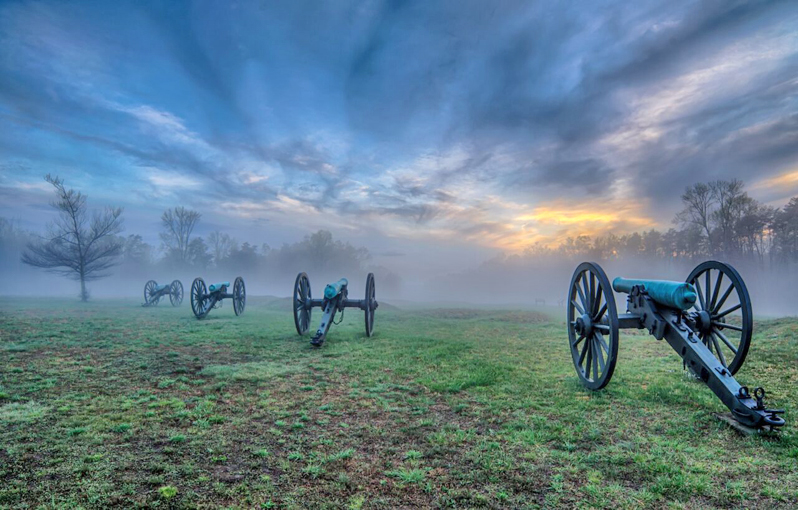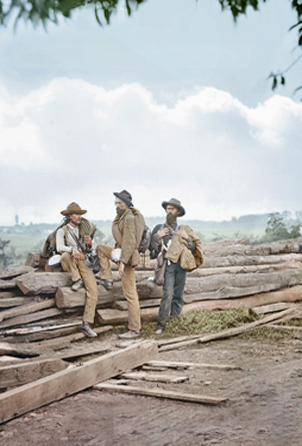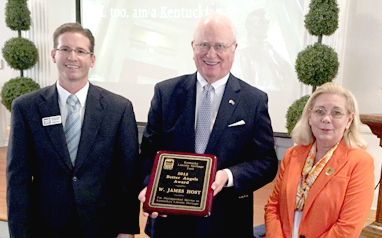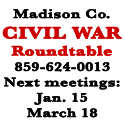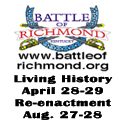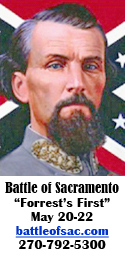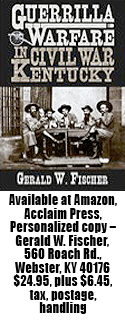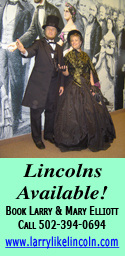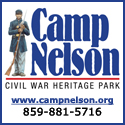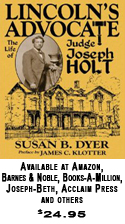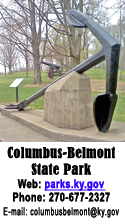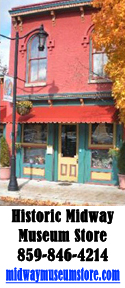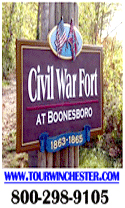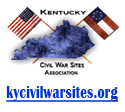|
Who was Civil War’s biggest man?
Look no further than Martin V.B. Bates
Three things distinguish Martin Van Buren Bates from other officers in the Confederate army.
He had a photographic memory, was merciless in avenging deaths of family members and was considered the largest man in the world.
The Letcher County native, who weighed 300 pounds at age 13, grew to a height of 7-feet-11 and a weight of 500 pounds. By age eight, he could relate history’s most important dates and events. At age 16, he enrolled at Emory and Henry College and became a teacher. More
Perryville, three others receive grants
totaling $525,878 from land-water fund
Some $91,000 in grants has been provided to the Perryville battlefield by the Land and Water Conservation Fund, part of an overall funding of $525,878 to help preserve more than 180 acres at three American Civil War battlefields.
In addition to Perryville, grants were awarded to Corinth, Miss, and Brandy Station in Virginia. Corinth received $170,820 for 88 acres and 51.2 acres at $109,836. Brandy Station was awarded $154,210 for 29 acres. More
Bugle editorial ...
What is gained by rewriting history?
In recent months, symbols of Southern history and culture have come under intense fire. For example …
• Following complaints, South Carolina Gov. Nikki Haley signed a bill to remove the Confederate flag from the capitol grounds.
• The New Orleans City Council voted to remove four Confederate monuments (Lee, Beauregard and Davis) from prominent places in the city.
• Mississippi voters soon will decide whether to replace the state flag (Confederate Battle Flag) with a new flag that would feature 20 white stars on a blue square.
• In Minnesota, activists demanded that a lake named after John C. Calhoun, a senator and vice president from South Carolina who was a proponent of slavery, be renamed.
• A Kentucky state official said a statue of Jefferson Davis, the president of the Confederacy and a native Kentuckian, should be removed from the Capitol rotunda in Frankfort. The statue is near a larger one of another Kentuckian, Abraham Lincoln, a proximity that made him uncomfortable, the official said.
• The Atlanta branch of the NAACP is calling for the immediate removal of all Confederate symbols from Georgia’s Stone Mountain Park, state-owned property that also houses a Civil War museum, hiking trails and other attractions. More
Cavalry soldiers were more than just men
on horseback, as many battles proved
The cavalries played an important role for both the North and South during the Civil War, but the term cavalry wasn’t necessarily interchangeable for anyone who rode a horse.
Cavalries were considered men on horseback who carried carbines, sabers and pistols. But only a small portion of the troops actually fit that description. More
Lincoln Trail Alliance honors Host
with inaugural Better Angels Award
Former Lincoln Heritage Trail advocate Jim Host has been presented the inaugural Better Angels Award for Distinguished Contribution to Kentucky’s Lincoln heritage.
Warren Greer, director of the Kentucky Lincoln Heritage Trail Alliance, presented the award in November. More
By placing it in limelight, Union turned
night into day in Fort Wagner siege
It was a strange invention, but it was the key to the Union’s effort to retake Charleston Harbor.
The dates were Sept. 5-6, 1863. And what made the difference was a calcium light, better known as “limelights.” These chemical lamps used superheated balls of lime, or calcium oxide, to create an incandescent glow. By shining the lights on Fort Wagner, Union forces were able to illuminate their artillery target while simultaneously blinding Confederate gunners and riflemen. More
The Right to Secede ...
Secession settled, Garfield declared,
in 'high court of war … there’s no appeal'
Much has been made of the fact that approximately one third of the West Point graduates fought for the Confederacy. Unfortunately, there has been misinformation here which has been manipulated to support one cause or the other. Officers and cadets from West Point took an oath, but it was not to the United States, or the president. Instead, their oath was to the Constitution. More
Murder of William (Bull) Nelson result
of confusion, misunderstanding, mistrust
During the Confederate invasion of Kentucky in 1862, an incident occurred at the Galt House in Louisville that would change the Union command of the Army of the Ohio and leave one Union general dead at the hands of another.
Gen. Jefferson C. Davis (no relation to the Confederate President Jeff Davis) shot and mortally wounded Gen. William (Bull) Nelson on Sept. 29, setting the stage for a new Federal commander for the Army of Ohio. The incident took place quickly, but it was played out against a background racked with confusion, misunderstanding and mistrust. More
|
|
|
|
Book review ...
Controversial Union Colonel Wolford
detailed in book by great-great nephew
Wild Wolf – The Great Civil War Rivalry, by Ronald Wolford Blair, Acclaim Press, December 2015, 460 pages, $29.95.
Today, only a few scholars are familiar with the name Col. Frank Lane Wolford. However, 150 years ago, this man was nationally known and in powerful oration, perhaps unwittingly, nearly changed the face of this country.
He had high cheekbones, an eagle like beak of a nose, his hair was black as coal, and he had piercing gray eyes. He had the stature and the resemblance of a wise Cherokee Chief. He was 5-foot-11 and weighed 180 pounds and, at the age of 47, had a powerful build. Wounded seven times, he fought in more than 300 battles and skirmishes. He was deeply loved and respected by his men and was known for his generosity. More
Sometimes you win, sometimes you lose
Morgan discovered at Cynthiana
John Hunt Morgan had many successes as a Confederate raider, but, at Cynthiana, he was one for two.
In the summer of 1862, Col. Morgan launched his first major raid into the Commonwealth. The famed “Thunderbolt of the Confederacy” hoped to disrupt Union army communications and to recruit in his adopted state. After leaving Knoxville, Morgan and his 800 troopers reached Cynthiana on July 17. The Central Kentucky town was strategically located on the Kentucky Central Railroad and the Licking River. More
Kentucky’s Civil War leaders …
Williams, nicknamed ‘Cerro Gordo,’
led with distinction throughout conflict
Confederate Brig. Gen. John Stuart Williams was once described as “proud, profane and utterly fearless in battle.”
He gained that reputation early on when he raised the Independent Kentucky Rifles company in Clark County and led his men with distinction in the Mexican War’s Battle of Cerro Gordo in April 1847. He helped the Americans win the day and forever after would be known as “Cerro Gordo.” More
Civil War’s last surviving soldier receives
final military honors on Veterans Day
On Veterans Day (Nov. 15), 59 years after he died and 150 years after he served in the Union Army, Albert Woolson received military honors once again at Park Hill Cemetery in Duluth, Minn.
The last surviving soldier confirmed to have served on either side of the Civil War, Woolson died in 1956 in Duluth, prompting national attention that lingers to this day.
On a mild, sunny November afternoon, about 70 people gathered to watch Civil War buffs dressed in Union uniforms re-enact parts of the service Woolson received at his funeral in 1956. One dressed and played a military drum much as Woolson did 150 years ago.
More
KCWRT ranks high in membership
among nation’s Civil War organizations
Lexington’s Kentucky Civil War Round Table, the Commonwealth’s largest such organization, is gaining on Brunswick (N.C.).
The Lexington organization, founded in 1953, currently has 354 members compared to Brunswick’s 500.
Although no umbrella organization exists, Matthew Borowick, the unofficial authority on the round tables, points out that the North Carolina group attracts more than 200 members to each meeting. He said it’s doubtful that any other round table will rival Brunswick’s total membership. More
Misidentified as Sue Mundy, Clarke
also may have been illegally hanged
The first mention of Jerome Clarke as Sue Mundy appeared in a newspaper on October 11, 1864.
George Prentice reported that a Lt. Flowers, her proper name being Sue Mundy, was one of the guerrillas that robbed a stagecoach near Harrodsburg. The driver had misidentified Jerome Clarke as a female.
The mistake was a reasonable one. Jerome had long shoulder length black hair and a pretty face, not handsome, but pretty. He had a waist like a woman and long delicate fingers. Except for his unusual height, six feet, he looked effeminate. This gave rise to rumors that he dressed in women’s clothing and coyly coaxed secrets from Union officers, or took rides in a buggy through Union lines to gain intelligence. More
Bugle Briefs
Deadline for Civil War markers March 1
Interested in obtaining a Civil War marker for your area? If so, contact the Kentucky Historical Society before March 1. That’s the next deadline for applications.
Applications can be downloaded at www.history.ky.gov/markers and by clicking on “how to apply for a historical marker.” For answers to questions, contact Marker Program Coordinator Becky Riddle at Becky.Riddle@ky.gov.
The second application deadline for 2016 is Sept. 1. More
|
|
|

